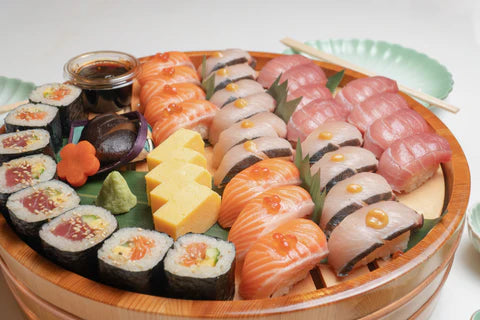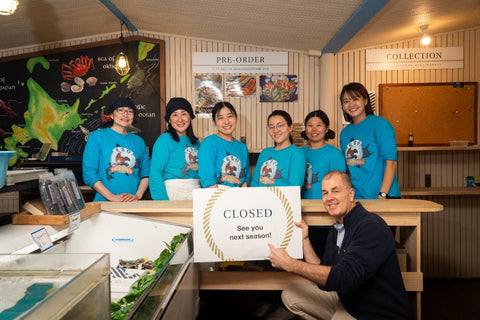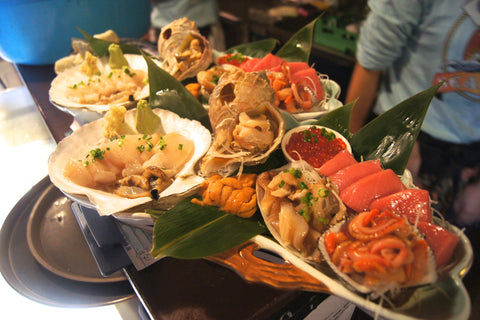江户前现在可以说是饮食文化中的流行词。据说“知情人士”在谈论寿司时会用到这个词,但它到底是什么意思呢?你可能会感到困惑,因为它实际上包含多种含义。

什么是江户前寿司?
简单来说,“江户前寿司”是一种传统的寿司,最初使用来自东京湾地区的新鲜食材,例如鳗鱼、小鲣鱼、金枪鱼和蛤蜊等。“江户”是东京的旧称,而“江户前”的意思是“江户前面”,指的是东京湾。
江户前寿司的广泛文化
然而,江户前寿司已不仅仅代表使用当地食材。它体现了江户时代(1603-1867 年)在“江户”(东京)发展起来的更广泛的寿司文化,包括各种鱼片切法、食谱、装饰和服务标准,甚至寿司厨师的制服。基本上,江户前就是寿司。

标志性的江户前厨师
当人们说“江户前”时,我想象一位厨师站在木制柜台和展示冰箱后面,穿着商务衬衫和领带,外面套着刚熨好的白色罩衫,白色围裙熟练地系成一个紧凑的结。他们戴着白色厨师帽,手握一把细长的“柳”刀,用于切生鱼片和寿司鱼配料。如果厨师符合这些条件,您就知道您来到了“江户前”的手中。他们在日本被尊称为“板前”。请记住,“江户前”是一种寿司文化。必须遵守规则,必须维护传统。江户前传统。


板前之技
“板前” (寿司专家)能熟练处理大约 20 种不同的鱼类。为了切鱼片,他们使用一种称为“Deba - bocho”的刀,这种刀比“Yanagi”更短,更重 刀。虽然江户前厨师们把鱼片切得非常简单,但要学会自信地切鱼片却需要花费很多年的时间。板前厨师还必须熟练掌握切鱼片做生鱼片和寿司配料(称为“Neta”)的技能。 (在日本,Neta 也被口语化地用来描述“内容”)。


精通装饰性切割
板前也是蔬菜装饰切割的专家。生鱼片通常放在简单的萝卜上,但实际上,这需要惊人的技巧。板前使用一种 20 厘米的矩形刀片(称为“薄刃 - 保长”),可以将 10 厘米的萝卜桶切成长达 3 米的薄如纸的卷轴。然后,他们将其分层,切成薄片,形成细丝状,然后放在生鱼片上。由于切片精细,它具有弹性蓬松的质感。

寿司饭的艺术
有些外行人会把寿司形容为“鱼饭”。但即使是最简单的寿司米饭,也需要用到醋、盐和糖,寿司厨师的搭配也多种多样。许多厨师会混合多种醋,并花费数年时间开发出一种独特的风味。真正的“江户前”风味米饭往往强调醋的风味,平衡甜味和咸味。最近,江户前厨师一直在使用手工醋酿造厂生产的“Akazu”(红醋)来获得更奢华的风味。在 Ezo Seafoods Fresh,我们混合了两种“Akazu”红醋。

各种江户前菜谱
板前还将提供一系列其他寿司主食的食谱,例如 Zuke——金枪鱼的经典做法,上桌前将鱼浸泡在甜酱油混合物中。这种做法不仅可以增强风味,还有助于保存鱼。(典型的配方包括 4 份浓酱油、1 份清酒和 1 份味醂)。玉子烧、干平、香菇和稻荷是其他一些需要特殊调味的著名寿司。

结论
因此,无论是在新雪谷的 Ezo Seafoods Fresh 买的寿司便当盒,还是在东京的高端寿司柜台吃的一顿饭,所有的寿司都受到江户前寿司原则的影响。在 Ezo Seafoods,您可以放心,您吃的寿司融合了最高标准的传统、风味和品质。





评论 (0)
这篇文章没有评论。成为第一个在此留言的人!